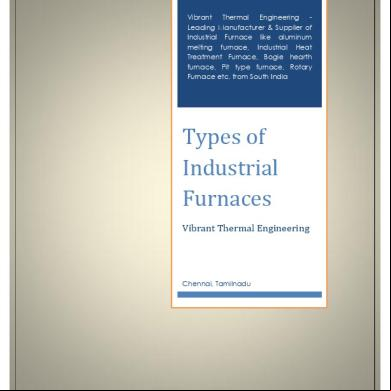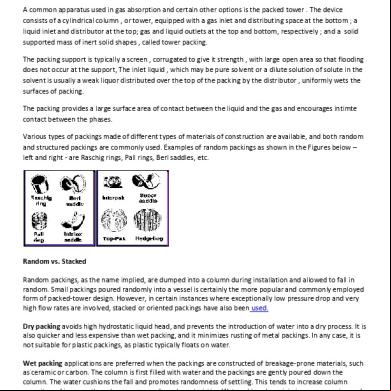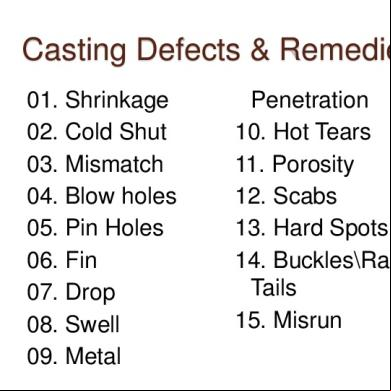Types Of Furnaces Used In Casting 5q6h3u
This document was ed by and they confirmed that they have the permission to share it. If you are author or own the copyright of this book, please report to us by using this report form. Report 3b7i
Overview 3e4r5l
& View Types Of Furnaces Used In Casting as PDF for free.
More details w3441
- Words: 1,178
- Pages: 29
After
moulding, preparing the molten metal plays an important role for casting. The molten metal is extracted from the furnace by melting the raw materials. The various types of furnaces are: 1. Cupola furnace, 2. Electric arc furnace, 3. Pit furnace, 4. Tilting / Rotary furnace, 5. Open hearth furnace.
It
is a cylindrical shaft furnace and the shell is made of 6 – 12 mm thick boiler plate and lined inside with refractory bricks. The refractory bricks consist of oxides of silica and alumina. This lining is thicker at the bottom than in the upper regions.
On the basis of reactions the entire shaft of the Cupola furnace is divided as: 1. Crucible Zone. 2. Tuyere Zone. 3. Combustion Zone. 4. Reducing Zone. 5. Melting Zone. 6. Preheating Zone. 7. Stack Zone.
Crucible Zone It is between top of the sand bed and bottom of the tuyeres. The molten metal is accumulated here. This is known as Well (or) Hearth of the furnace. Tuyere Zone It is between bottom of the tuyeres to top of the tuyeres where hot air enters the furnace.
Combustion (or) Oxidizing Zone The temperature reaches to 15000C – 18500C and the molten drops of cast iron enter into the hearth. The chemical reactions occur in this zone are: C + O2 CO2 + Heat Si + O2 SiO2 + Heat Mn + O2 MnO2 + Heat
Reducing Zone It extends from top of combustion zone to top of the coke bed. Here CO2 reduces to CO [Carbon Monoxide] and the temperature drops above 12000C. Due to these reactions the charge is protected from any oxidation influence.
Melting Zone It is the first layer of the iron above the coke bed, melting of iron starts from this zone. A considerable amount of iron is picked up by the molten metal. CO2 + C 2CO – Heat (Reducing Zone) 3Fe + 2CO Fe3C + CO2 – Heat
Preheating Zone It is above melting zone and extends up to bottom of the charging door. This zone contains alternate layers of coke, flux, pig iron, scrap and are heated up to 11000C. Stack Zone It extends from preheating zone to the top of cupola furnace. In this the gasses evolve from the preheating zone will be carried away to the atmosphere.
Preparation
of the Cupola Firing the Cupola Charging the Cupola Soaking of iron Opening the air blast Tapping and Slagging
Electric
arc furnaces are used for melting and refining all kinds of steels including stainless steel and other alloy steels. In this furnace, the source of heat is continuous (or) established between the electrodes and the charged material. Principle: It converts electric energy to thermal energy by creating arc between the electrodes and the charge.
The
charge is placed in a furnace through the roof and then closed. The electrodes are lowered. The power supply is switched on. The three carbon electrodes carry current. Heat is generated when resistance is offered to the electricity flow. In this case, the metal charge provides resistance and when the metal is melted, the slag offers resistance within 2 hours.
The
charge melts. The power is switched off, the electrodes are raised. The furnace is tilted to pour the molten metal in to the ladle. The temperature in the furnace can be as high as 19250c.
Arc furnaces are classified as follows. 1. Direct arc furnace, 2. Indirect arc furnace.
It
consists of a round, bowl shaped carbon hearth with a dome shaped roof ing one or more carbon electrodes through which the current es. The arc forms between the charged material and the electrode, the charge is heated both by current ing through the charge and by the radiant energy evolved by the arc. This type of furnace can be used either stationary or made to tilt.
The
roof is usually so made that it can be removed for charging purposes. The capacity of these furnaces for production work varies from 3 to 10 tons. These are best suited for laboratory work where very small quantity of a few kg is needed for research work. These furnaces give high melting rate, high pouring temperature and excellent control of metal analysis and temperature. The fig shows the direct arc furnace.
It
consists of a horizontal cylinder lined with a refractory material with two electrodes on the horizontal axis. An arc is struck is between the electrodes in the center of the furnace. The arc doesn’t come in with the metal to be melted, the heat being given to the charge by radiation from the arc and reflection from the walls of the furnace.
The
furnace is designed to give a rocking motion as the melting proceeds, thus quickening up the melt by distributing the heat more rapidly. The charging, tapping and slagging are done through an opening in the side of the furnace.
It
is used for the melting of non-ferrous metals. Its capacity may range from 30 to 150 kg. The types of crucible furnace are: 1. Pit furnace 2. Coke fired stationery furnace 3. Oil fired tilting furnace 4. Pot furnace.
As
the name implies, it is made in the form of a pit below the ground level, so that the crucible can be conveniently lifted, operating from the floor of the shop.
Crucibles are made up of refractory materials or alloy steels. The crucible is placed in a pit below the floor level. The furnace is usually fired with coke. Sufficient coke is being packed round and above the crucible pot, to melt and superheat the charge without reheating with coke. When the metal reaches the desired temperature, the crucible is lifted from the pit and the molten metal is poured in to the mould.
It
is provided with a removable fire gate and ash pit below the furnace. The inner lining of the furnace above the gate is made of fire-bricks and the natural draught provided by a tall chimney is controlled by means of a loose brick or damper at the foot of the stack. Crucible furnaces are used to melt nonferrous metals like bronze, brass, aluminium and zinc alloys.
The
crucible is placed in a pit below the floor level, it is fired with coke. The charge to be melted is placed in crucible; coke is packed around the crucible. Natural draft is provided by a tall chimney. Many crucibles can be placed in a single pit. After the metal is melted, the covers are removed, the crucibles are lift out with the help of tongs and taken to pouring placed. This furnace is used for melting non ferrous metals.
moulding, preparing the molten metal plays an important role for casting. The molten metal is extracted from the furnace by melting the raw materials. The various types of furnaces are: 1. Cupola furnace, 2. Electric arc furnace, 3. Pit furnace, 4. Tilting / Rotary furnace, 5. Open hearth furnace.
It
is a cylindrical shaft furnace and the shell is made of 6 – 12 mm thick boiler plate and lined inside with refractory bricks. The refractory bricks consist of oxides of silica and alumina. This lining is thicker at the bottom than in the upper regions.
On the basis of reactions the entire shaft of the Cupola furnace is divided as: 1. Crucible Zone. 2. Tuyere Zone. 3. Combustion Zone. 4. Reducing Zone. 5. Melting Zone. 6. Preheating Zone. 7. Stack Zone.
Crucible Zone It is between top of the sand bed and bottom of the tuyeres. The molten metal is accumulated here. This is known as Well (or) Hearth of the furnace. Tuyere Zone It is between bottom of the tuyeres to top of the tuyeres where hot air enters the furnace.
Combustion (or) Oxidizing Zone The temperature reaches to 15000C – 18500C and the molten drops of cast iron enter into the hearth. The chemical reactions occur in this zone are: C + O2 CO2 + Heat Si + O2 SiO2 + Heat Mn + O2 MnO2 + Heat
Reducing Zone It extends from top of combustion zone to top of the coke bed. Here CO2 reduces to CO [Carbon Monoxide] and the temperature drops above 12000C. Due to these reactions the charge is protected from any oxidation influence.
Melting Zone It is the first layer of the iron above the coke bed, melting of iron starts from this zone. A considerable amount of iron is picked up by the molten metal. CO2 + C 2CO – Heat (Reducing Zone) 3Fe + 2CO Fe3C + CO2 – Heat
Preheating Zone It is above melting zone and extends up to bottom of the charging door. This zone contains alternate layers of coke, flux, pig iron, scrap and are heated up to 11000C. Stack Zone It extends from preheating zone to the top of cupola furnace. In this the gasses evolve from the preheating zone will be carried away to the atmosphere.
Preparation
of the Cupola Firing the Cupola Charging the Cupola Soaking of iron Opening the air blast Tapping and Slagging
Electric
arc furnaces are used for melting and refining all kinds of steels including stainless steel and other alloy steels. In this furnace, the source of heat is continuous (or) established between the electrodes and the charged material. Principle: It converts electric energy to thermal energy by creating arc between the electrodes and the charge.
The
charge is placed in a furnace through the roof and then closed. The electrodes are lowered. The power supply is switched on. The three carbon electrodes carry current. Heat is generated when resistance is offered to the electricity flow. In this case, the metal charge provides resistance and when the metal is melted, the slag offers resistance within 2 hours.
The
charge melts. The power is switched off, the electrodes are raised. The furnace is tilted to pour the molten metal in to the ladle. The temperature in the furnace can be as high as 19250c.
Arc furnaces are classified as follows. 1. Direct arc furnace, 2. Indirect arc furnace.
It
consists of a round, bowl shaped carbon hearth with a dome shaped roof ing one or more carbon electrodes through which the current es. The arc forms between the charged material and the electrode, the charge is heated both by current ing through the charge and by the radiant energy evolved by the arc. This type of furnace can be used either stationary or made to tilt.
The
roof is usually so made that it can be removed for charging purposes. The capacity of these furnaces for production work varies from 3 to 10 tons. These are best suited for laboratory work where very small quantity of a few kg is needed for research work. These furnaces give high melting rate, high pouring temperature and excellent control of metal analysis and temperature. The fig shows the direct arc furnace.
It
consists of a horizontal cylinder lined with a refractory material with two electrodes on the horizontal axis. An arc is struck is between the electrodes in the center of the furnace. The arc doesn’t come in with the metal to be melted, the heat being given to the charge by radiation from the arc and reflection from the walls of the furnace.
The
furnace is designed to give a rocking motion as the melting proceeds, thus quickening up the melt by distributing the heat more rapidly. The charging, tapping and slagging are done through an opening in the side of the furnace.
It
is used for the melting of non-ferrous metals. Its capacity may range from 30 to 150 kg. The types of crucible furnace are: 1. Pit furnace 2. Coke fired stationery furnace 3. Oil fired tilting furnace 4. Pot furnace.
As
the name implies, it is made in the form of a pit below the ground level, so that the crucible can be conveniently lifted, operating from the floor of the shop.
Crucibles are made up of refractory materials or alloy steels. The crucible is placed in a pit below the floor level. The furnace is usually fired with coke. Sufficient coke is being packed round and above the crucible pot, to melt and superheat the charge without reheating with coke. When the metal reaches the desired temperature, the crucible is lifted from the pit and the molten metal is poured in to the mould.
It
is provided with a removable fire gate and ash pit below the furnace. The inner lining of the furnace above the gate is made of fire-bricks and the natural draught provided by a tall chimney is controlled by means of a loose brick or damper at the foot of the stack. Crucible furnaces are used to melt nonferrous metals like bronze, brass, aluminium and zinc alloys.
The
crucible is placed in a pit below the floor level, it is fired with coke. The charge to be melted is placed in crucible; coke is packed around the crucible. Natural draft is provided by a tall chimney. Many crucibles can be placed in a single pit. After the metal is melted, the covers are removed, the crucibles are lift out with the help of tongs and taken to pouring placed. This furnace is used for melting non ferrous metals.










